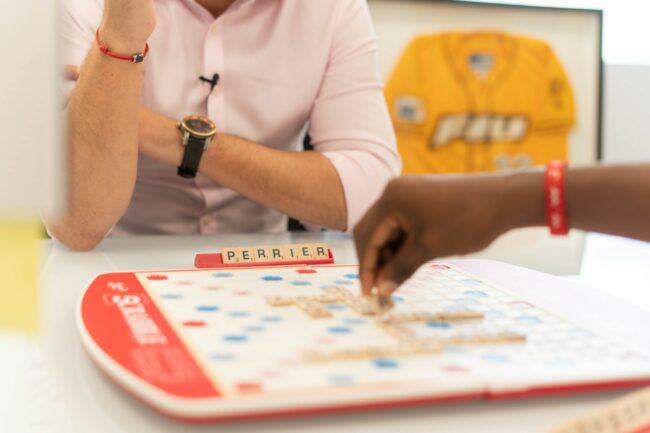Looking for an engaging activity to share with friends and family? Curious about how long a game of Scrabble actually takes? You’re in the right place. In this editorial article, we’ll provide an in-depth look into the time investment needed for a Scrabble game, from setup to the last tile placement, along with tried-and-true advice for making your gameplay efficient.
Table Of Contents
−- Grasping the Fundamentals of Scrabble Rules
- Selecting the Right Dictionary
- Setting Your Game’s Time Frame
- Preparing the Board and Initial Setup
- The Draw: Choosing and Arranging Tiles
- Scoring: More than Just Letters
- Mastering Blocking Tactics
- Recognizing Acceptable Words
- Bonuses and Penalties: The Fine Print
- Concluding the Game: Final Scores and Beyond
Grasping the Fundamentals of Scrabble Rules
Understanding the core rules of Scrabble is paramount to playing the game as it’s intended. The objective is straightforward: accumulate the highest score possible by the time all the tiles are utilized. In Scrabble, you can play with two to four participants. During each turn, you’ll draw seven tiles from a lettered bag and use these letters to form words on the board.

But it doesn’t end there. You’ll encounter special tiles that offer bonus points, and certain rules can either elevate your score or bring it crashing down. You must also keep an eye out for blocking tactics—deliberate moves made to prevent other players from creating high-scoring words. Understanding these subtleties won’t just make you an informed player; it can also sharpen your competitive edge.
Selecting the Right Dictionary
A dictionary is your go-to resource for word validation in Scrabble. It establishes what words are permissible and helps you understand their meanings. While you have a myriad of dictionary choices, Scrabble purists often opt for the Merriam-Webster Unabridged Dictionary. Familiarizing yourself with your chosen dictionary before you play is crucial, especially if you’re setting a time limit for your game.
Setting Your Game’s Time Frame
Timing plays a crucial role in Scrabble; a game can be as short as 30 minutes or stretch over several hours, depending on the participants’ skill levels. Some players use tools like a three-minute hourglass or even a chess clock, set to 25 minutes per player, to keep the game moving at a steady pace.
If your players are novices, anticipate a longer game as everyone gets to grips with the rules. No matter what, you should define the time limitations upfront to ensure everyone is on the same page and the game remains engaging for all.
Preparing the Board and Initial Setup
Once you’ve picked your dictionary and agreed on a time frame, the next logical step is setting up your board and pieces. Place the board at the center of your playing area and draw your tiles. Make sure every player starts with an equal number of tiles, usually seven. This initial setup dictates how smoothly and quickly the game will progress, so it’s worth spending a few extra minutes to get it right.
The Draw: Choosing and Arranging Tiles
In Scrabble, your first tactical move happens even before word formation—it’s in how you draw and arrange your tiles. Each player should pull seven tiles from the bag and align them on their tile rack. Keep in mind, the rules prevent you from shuffling your tiles once they’re on the rack. If you’re not thrilled with your draw, you can opt for a second chance but at the cost of returning a tile.
Scoring: More than Just Letters
As the game advances, keep track of your scores. Points come not only from the letters you use but also from the complexity and positioning of your words. The board contains special spaces that yield bonus points—double or triple letter scores and double or triple word scores. And let’s not forget—there’s a finite number of tiles in the bag, and keeping track helps you anticipate the game’s end.
Mastering Blocking Tactics
In Scrabble, you don’t just play the board; you play your opponents. An effective blocking strategy can be a game-changer. By skillfully positioning your tiles, you can limit your opponent’s access to high-scoring opportunities or even restrict their ability to create words altogether. It’s a valuable skill set that adds an additional layer of strategy to your gameplay.
Recognizing Acceptable Words
Knowing what words are valid according to the agreed-upon dictionary can make or break your game. Words that might be colloquially acceptable may not pass the Scrabble test. Be wary of proper nouns, abbreviations, and slang, which are often off-limits. It’s important to set these guidelines at the onset to avoid any disputes later.
Bonuses and Penalties: The Fine Print
Scrabble is a game of bonuses and penalties as much as it is of words. You can earn extra points for crafting long words or using up all your tiles in a single turn. On the flip side, playing an invalid word can cost you dearly, emphasizing the importance of understanding the game rules and your chosen dictionary thoroughly.
Concluding the Game: Final Scores and Beyond
When all is said and done, the player with the highest accumulated points wins. Scoring isn’t just about adding; it’s also about subtracting any penalties accrued during gameplay. And in the event of a tie? The player with fewer remaining tiles emerges victorious. As you pack up the board and reflect on your game, you’ll likely find yourself already planning strategies for the next round.

Editorial Staff
Our writers, editors, content managers, and SEO specialist. We all take part in crafting amazing articles. We spend hours ensuring that each article is based on facts, researched, and thorough. You'll never want to click the back button to look for more answers other than here!
